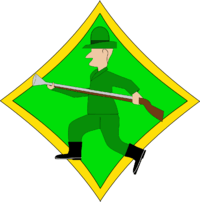Jagdgeschwader 50
| Jagdgeschwader 50 | |
|---|---|
|
Emblem of JG 50 | |
| Active | July–October 1943 |
| Country |
|
| Branch |
|
| Type | Fighter Aircraft |
| Role | Air superiority |
| Size | Air Force Wing |
| Commanders | |
| Notable commanders | Hermann Graf |
| Aircraft flown | |
| Fighter | Bf 109 |
Jagdgeschwader 50 (JG 50), sometimes erroneously referred to as Jagdgruppe 50, was a special high-altitude fighter unit that was intended to be specialized in intercepting the Royal Air Force's de Havilland Mosquito light bombers during World War II.
History

On 21 July 1943, Jagdgruppe Süd der ObdL was formed as a high-altitude fighter unit to combat the RAF's Mosquito twin-engine bomber and reconnaissance aircraft. On 15 August 1943 the unit was redesignated Jagdgeschwader 50 and was commanded by Major Hermann Graf, the first pilot in history to achieve 200 aerial victories. Both JG 50 (and its sister unit Jagdgeschwader 25) were ultimately unsuccessful in effectively countering the Mosquito and were more successfully used for interception of the US heavy bomber formations during the daylight offensive over Europe in 1943-44. Only one Mosquito was taken down, and even that is subject to dispute.[1]
JG 50 were initially equipped with eight Messerschmitt Bf 109G-5s and Bf 109G-6s polished to increase speed, and equipped with a special internal tank for liquefied nitrous oxide as part of the GM-1 engine power boosting system, which was injected directly into the supercharger intake. This allowed the pilot to boost the rated horsepower of the DB 605 engine. The unit was later also equipped with specially supercharged FW-190A-5.

Graf was allowed to pick any pilots he wished for the new unit, and he chose a further three aces ObLt. Alfred Grislawski, Obfw. Ernst Süß, and Fw. Heinrich Füllgrabe from his old Staffel - the 9. Staffel of JG 52, also known as Karaya-Staffel, after their emblem, a heart hit by an arrow underlined with the word Karaya (which was the title of their favourite song). Collectively they were known as the "Karaya Quartet".
Graf was charged with assessing new methods of attacking American bomber formations. He developed the "company front" attack, and was to assess weapons the fighters could use against the bombers. JG 50 was the first formation to use the Werfer-Granate 21 rocket mortar, with one carried under each wing. While these rockets could bring down a bomber with one hit, they were designed to disperse the tightly packed bomber formations rather than as a direct fire weapon.
On 31 July 1943 the unit was declared operational, with a total of 19 aircraft. On 17 August 1943 the unit was one of those who intercepted American bomber forces attacking the Messerschmitt factory in Regensburg and the ball bearing plants in Schweinfurt. Grislawski claimed two Boeing B-17 Flying Fortresses downed on this raid. On 6 September the unit's pilots shot down four Flying Fortresses over Stuttgart, one to Grislawski, and two claimed by Graf with the WfGr.21, who was then shot down but survived a forced landing. Grislawski claimed one other kill with the unit, a B-17 on 14 October.
By October, JG 50 had been disbanded and merged with I Gruppe, JG 301. Graf was appointed commander of JG 11 in November 1943. On 6 November 1943 Grislawski was appointed Staffelkapitän of 1./JG 1 based at Deelen, the Netherlands. Two of the Karaya Quartet survived the war; Süß and Füllgrabe were killed in action.
See also
- Mimi Thoma
Notes
- ↑ "Serial Killers: Jagdgeschwader 50". Retrieved 17 December 2015.
External links
- JG 50 @ Lexikon der Wehrmacht
- JG 50 @ Feldgrau.com
- JG 50 @ The Luftwaffe, 1933-45
- The Karaya Song - Namesake Of 9./JG52 JG4_Karaya This is the famous record and song by Mimi Thoma that lent 9./JG52 its name! YouTube Karya, am Flügel: Georg Haentzschel, Telefunken A 1746/B~20268
